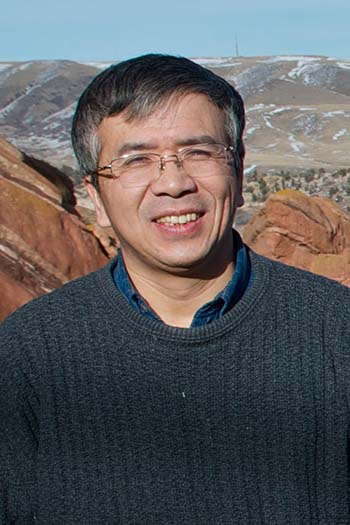
Hui Wei
Researcher IV-Molecular Biology
Hui.Wei@nrel.gov
303-384-6620
 https://orcid.org/0000-0002-3550-188X
https://orcid.org/0000-0002-3550-188X
Research Interests
Genetic modification of plants with glycoside hydrolase and biocatalyst overexpression to increase the biomass pretreatability and digestibility
Genetic engineering of yeast and bacteria for the production of advanced biofuels
Biomaterials and biomanufacturing
Affiliated Research Programs
- Targeted Microbial Development
- Advanced concepts for producing hydrocarbons, 2015–present
- Targeted Conversion Research
- Biological transformation, 2012–2014
- Pretreatment and biomass deconstruction process development, 2013
- Energy Frontier Research Centers, Center for Direct Catalytic Conversion of Biomass
to Biofuels, Phase I and Phase II projects
- Tailored biomass and nano-catalysts: Manipulate the biochemical and biophysical properties of plant cell walls to enhance designated physical/chemical catalytic routes, 2009–present
- BioEnergy Science Center, Phase I and Phase II projects
- adhE characterization and pyruvate decarboxylase engineering, 2015
- In planta expression of glycoside hydrolases, 2012
- Laboratory Directed Research and Development projects
- Next-generation in planta expression of glycoside hydrolases to reduce plant cell wall recalcitrance, 2014–present
- Understanding natural paradigms for plant cell wall deconstruction: community dynamics and structure of the decaying poplar wood pile, 2008–2010
Education
Ph.D., Plant and Microbial Physiology, Queen's University, 1998–2003
M.S., Microbiology, Central China Agricultural University, 1985–1988
B.S., Genetics, Wuhan University, 1981–1985
Professional Experience
Senior Scientist I, National Renewable Energy Laboratory (NREL), 2013–present
Scientist III, NREL, 2011–2013
Research Associate, NREL, 2008–2011
Visiting Fellow, National Institutes of Health, 2005–2008
Postdoctoral Researcher, Iowa State University, 2003–2005
Research Assistant, Queen's University, 1998–2003
Research Scientist, Wuhan Institute of Virology, Chinese Academy of Science, 1988–1998
Featured Publications
Transgenic Ferritin Overproduction Enhances Thermochemical Pretreatments in Arabidopsis, Biomass Bioenergy (2015)
The transgenic Arabidopsis plants that overexpress soybean ferritin (referred to as FerIN) accumulated iron during growth under both normal and iron-augmented watering conditions. Prussian blue staining showed punctuated staining of iron predominantly on the interior surfaces of cell lumen in FerIN plants. The harvested transgenic biomass showed enhanced pretreatability in that it released 13%–19% more glucose and xylose than empty vector control plants and improved enzymatic conversion compared to plant biomass subjected to the exogenous addition of iron co-catalysts (i.e., by soaking).
Identifying the Ionically Bound Cell Wall and Intracellular Glycoside Hydrolases in Late Growth Stage Arabidopsis Stems: Implications for the Genetic Engineering of Bioenergy Crops, Frontiers Plant Science (2015)
Nonstructural proteins were isolated from the late growth stage Arabidopsis whole stems, followed by the in-solution and in-gel digestion methods coupled with Nano-LC-MS/MS, bioinformatics, and literature analyses. In total, 75 proteins were identified using the in-solution method, and 236 proteins were identified using the in-gel method, among which approximately 10% of proteins were predicted to be secreted, including 7 GHs. Half of the GHs are xylan- or hemicellulose-modifying enzymes, which will likely have an impact on cellulose accessibility and have implications for the genetic engineering of bioenergy crops.
Engineering Towards a Complete Heterologous Cellulase Secretome in Yarrowia lipolytica Reveals its Potential for Consolidated Bioprocessing, Biotechnology for Biofuels (2014)
For the development of a direct microbial conversion platform for the production of hydrocarbon fuels from cellulosic biomass, the potential for oleaginous yeast Y. lipolytica as a consolidated bioprocessing strain was investigated by expressing critical cellulases. The expressed Trichoderma reesei - Talaromyces emersonii chimeric CBHI showed a specific activity on Avicel that is comparable to the native T. reesei CBHI and has a significant synergism with EGII and CBHII in degrading cellulose in a co-culture consortia system.
Additional Publications
In Situ Micro-Spectroscopic Investigation of Lignin in Poplar Cell Walls Pretreated by Maleic Acid, Biotechnology for Biofuels (2015)
Chapter 1: Feedstock Engineering and Biomass Pretreatments: New Views for a Greener Biofuels Process, in Direct Microbial Conversion of Biomass to Advanced Biofuels (2015)
Chapter 10: Identification of Genetic Targets to Improve Lignocellulosic Hydrocarbon Production in Trichoderma reesei Using Public Genomic and Transcriptomic Datasets, in Direct Microbial Conversion of Biomass to Advanced Biofuels (2015)
Comparison of Transcriptional Profiles of Clostridium thermocellum Grown on Cellobiose and Pretreated Yellow Poplar Using RNA-Seq, Frontiers in Microbiology (2014)
Heterologous Expression of Xylanase Enzymes in Lipogenic Yeast Yarrowia lipolytica, PLOS One (2014)
Chapter 2: Basic Biological Research Relevant to Feedstock Conversion, Compendium of Bioenergy Plants: Corn (2014)
NIR and Py-mbms Coupled with Multivariate Data Analysis as a High-Throughput Biomass Characterization Technique: A Review, Frontiers in Plant Science (2014)
Analysis of Transgenic Glycoside Hydrolases Expressed in Plants: T. reesei CBH I and A. cellulolyticus EI, Biomass Conversion: Methods in Molecular Biology (2012)
Tracking Dynamics of Biomass Composting by Monitoring the Changes in Substrate Structure, Microbial Community, and Enzyme Activity, Biotechnology for Biofuels (2012)
Elucidating the Role of Ferrous Ion Cocatalyst in Enhancing Dilute Acid Pretreatment of Lignocellulosic Biomass, Biotechnology for Biofuels (2011)
Natural Paradigms of Plant Cell Wall Degradation, Current Opinion in Biotechnology (2009)
View all NREL Publications for Hui Wei.
Share

